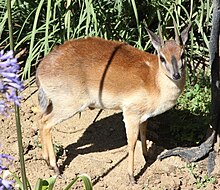Red duiker
| Red duiker | ||||||||||||
|---|---|---|---|---|---|---|---|---|---|---|---|---|

Red duiker |
||||||||||||
| Systematics | ||||||||||||
|
||||||||||||
| Scientific name | ||||||||||||
| Cephalophus natalensis | ||||||||||||
| A. Smith , 1834 |
The red duiker ( Cephalophus natalensis ), also known as Natal red duiker , is a small, stocky antelope that inhabits the evergreen and riverbank forests on the southeast coast of Africa from southern Tanzania , southeastern Malawi , Mozambique , Swaziland to eastern South Africa ( Mpumalanga and KwaZulu-Natal ). inhabited. The area of distribution is no longer contiguous today, but rather fragmented by agriculture, human-inhabited areas and commercial logging. The red duiker was extinct south of Durban, but has since been resettled in some areas. The IUCN classifies the red duiker as not endangered (least concern).
features
This antelope, belonging to the duckers, weighs 12 to 14 kg and reaches a length of 75 to 87 cm, with a tail length of 9 to 14 cm and a shoulder height of 43 cm. She wears a strong, red-brown hair coat that is lighter around the chin and throat, the neck of the fully grown red duiker turns blue-gray. Both sexes have short, straight horns pointing backwards, which can be 7 cm long in males and 3.5 cm long in females. The noticeable scent glands, visible as black lines on the sides of the head below the eyes, become 2 cm long.
behavior
Red duikers live individually, as a pair or as a female with young, sometimes in small groups of 3 to 5 animals. Adolescent red duikers wander far and wide. Adult red duikers sometimes avoid each other. The districts are marked by rubbing the scent glands on branches, twigs and tree trunks. Foreign red duiker that have invaded the territory are driven away at great speed. Well-known animals greet each other by rubbing their eye glands against each other. Red duiker have common droppings.
They feed in the morning and late afternoon, but in heavily human-influenced areas they are only active at night. They spend the day chewing the cud and only go looking for food for a short time. They eat leaves, fruits and flowers, and grass only rarely. They also often accompany groups of monkeys and consume the fruits and fruit scraps that they drop. In the early morning or evening they also go to gardens near the forest to look for food. They spend the night hidden in thick vegetation.
They reproduce all year round. After a gestation period of about 210 days, a single cub is born, weighing about one kilogram at birth. There are about 235 days between the individual births.
literature
- Gus Mills, Lex Hes: Mammals of Southern Africa. An illustrated encyclopedia. Könnemann, Cologne 1999, ISBN 3-8290-3610-8 .
- Jonathan Kingdon: The Kingdon Pocket Guide to African Mammals. A & C Black Publishers Ltd., London 2004, ISBN 0-7136-6981-0 .
Web links
- Cephalophus natalensis in the Red List of Threatened Species of the IUCN 2006. Posted by: Antelope Specialist Group, 1996. Retrieved on 11 May, 2006.
